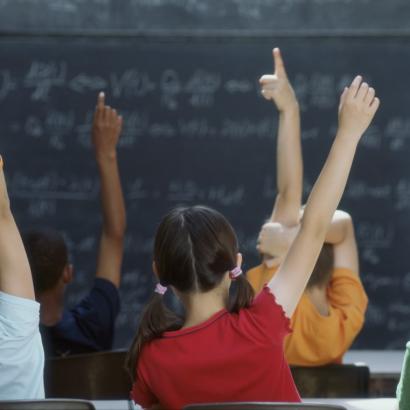- Education
This interview focuses on a chapter from A Nation at Risk +40, a report by the Hoover Education Success Initiative (HESI) that looks back at the birth, struggles, and future of the modern school reform movement. (Download the publication here.)
Michael T. Hartney is a fellow at the Hoover Institution whose scholarly expertise is in American politics and public policy with a focus on state and local government, interest groups, and K–12 education policy. He is the author of an essay on “student-centered systems.” Hartney spoke with Chris Herhalt about lessons learned from a half century of K–12 education reform in the United States.
Chris Herhalt: Does the US school system, with its fifteen thousand individual school districts, need consolidation? Is decentralization part of the problem?
Michael Hartney: I do think that it’s a challenge to drive a focus on outcomes when you have so much decentralization. You have a lot of what I call in the paper “veto points”—places where a big policy reform can be derailed at the implementation stage. Thinking about No Child Left Behind (NCLB), for example, since that was the biggest effort to date to drive student performance through accountability, a lot of the law fizzled when it came time for local school districts, school boards, and superintendents to implement it as it was intended.
I’m not necessarily convinced that there is a way to centralize the system, and there certainly would be trade-offs if we had a more centralized system. But I do think the decentralized nature of American education is a cautionary tale for reformers who have grand ambitions about a single policy reform. I think what I try to get through in the paper is that reformers need to think every time they propose policy changes about how those changes mesh with the decentralized structure we have, which is unlikely to change.
Herhalt: Would your recommendations on school board election reform overcome the significant power wielded by teachers’ unions?
Hartney: We have this quaint notion that American education is decentralized: that it’s Tocquevillian, and local stakeholders—community members—can participate in choosing their school board members. When people propose to change elected school boards by making them appointed or getting rid of them, even though very few members of the public actually vote in these elections, you get a lot of pushback. Inherently and symbolically, people are very passionate about the idea of local democracy.
So, what I’m getting at with those proposed reforms is that we don’t really have authentic local democracy because just a handful of people participate in these elections. Special-interest groups tend to dominate. What if we could provide information on how schools are performing that’s aligned with when elections are going to happen? Like making sure report cards come out before an election, or timing the elections when more people are likely to vote. Democracy’s always going to have some warts, but I think those are promising ways to make sure that you come closer to representing the average voter in the community as opposed to just those who are paying attention when the off-cycle election is held.
Herhalt: If you could design a new NCLB or Race to the Top, what broad strokes would it include? Does federal legislation matter the way we think it does?
Hartney: I think there was a path forward to reforming No Child Left Behind that didn’t require throwing out the entire law. The big thing that the law got wrong was that it judged schools based on student proficiency, which we know is often just a mirror image of the socioeconomic status of the community. If they had gone back to the table and reformed the law so that deciding whether a school was meeting adequate yearly progress was based on student growth—that is, how much the students improved from the time they showed up in the classroom to the end of the school year—then I think that conversation might have looked a lot different. And the politics surrounding No Child Left Behind wouldn’t have gone south so quickly.
But more broadly, one thing we’ve learned in the past several decades, certainly since A Nation at Risk, is that the federal government’s primary way of playing a positive role in education is going to be more through the bully pulpit. The success of No Child Left Behind was really in shining a light on achievement gaps, which states and localities had been able to obscure before the law required that students be tested in fourth and eighth grade and that data reported.
Now, what the federal government can do is condition federal funding, as it does under the law that came to replace NCLB, the Every Student Succeeds Act. States are still expected to test their students and publicize those results. The only difference is that there isn’t consequential accountability if students don’t make progress. Some people think that’s a negative thing. But on the other hand, the feds don’t have a great track record of parlaying consequences into authentic change at the district level. It becomes a compliance exercise. For example, if schools failed under NCLB, they would be told, “You have to provide supplementary tutoring services or provide school choice to the students in your district.” But oftentimes, those districts didn’t have any high-performing schools nearby. So “choice” was really only a compliance exercise that didn’t amount to any changes for families and students.
I do think that among the lessons is that higher levels of government have a role in ensuring that states and localities provide accurate information about how students are doing. But when it comes to prescriptive “you must do A, you must do B,” in terms of school reform, I think we’ve learned that’s not a very successful way to change things.
Herhalt: Part of your chapter is devoted to state and municipal takeovers of school districts, with a particular emphasis on their ability to push teachers’ unions and other stakeholders to stop talking about what they want and focus on the kids. Should this approach be used more often, or is it too adversarial and disruptive?
Hartney: I think it can yield results, but it’s not a guarantee of results. For certain dysfunctional school districts, takeovers can be necessary, but they’re not going to be sufficient to drive student performance improvements. Takeovers create the space for leaders to come in and make important changes, but the leaders have to follow through. And the most important change is that if you’re going to take over a district, you need to make sure that if, for example, you’re going to close schools or invite charter authorizers into the district, the resulting schools are better than the ones the students used to be in. If you don’t do that, I think you’re just rearranging the deck chairs on the Titanic.
One common criticism of takeovers is that they’re anti-democratic. I think it’s more complicated than that. Take Washington, DC, for example, which is arguably one of the bigger turnaround stories in the past couple of decades. DC, even for a large, low-income school district, performed quite a bit worse than comparably large and low-income districts before it was taken over and put in the hands of the now well-known former chancellor, Michelle Rhee. In the report I discuss how her counterpart in the teachers’ union admitted after he had left office that consolidating political authority in the hands of the mayor, who would then choose the chancellor, made it a lot more difficult for his union to block reforms they’d been skeptical of.
For instance, Rhee was able to use that governance power to avoid bargaining with the teachers’ unions over how teachers would be evaluated. She was able to bring in an entirely different compensation system to reward educators who were improving outcomes for kids the most. It was at that nexus of governance reform where you saw real policy change. But the problem is you can’t just assume that if a district does a takeover, it’s going to have a Michelle Rhee or then–mayor Adrian Fenty come into the void and make all of these really muscular reform choices for kids.
We’ve seen it on occasion. We’ve seen Mike Bloomberg and Joel Klein have a lot of success in New York City. We saw in the aftermath of Hurricane Katrina in New Orleans that that district was able to make some really big strides. So, there are plenty of examples where takeovers have led to good outcomes, but on average, they don’t tend to. That’s not because takeovers can’t incubate that change. It’s because you don’t often have leaders willing to push that vision of reform into the space that has opened up.
Herhalt: Should more superintendent or even principal contracts contain provisions holding them accountable for student achievement and maintaining outcomes? And why isn’t this the case today?
Hartney: To answer your question on why it’s not the case, I think it’s largely the culture of education. The major thing, of course, that A Nation at Risk changed is that before the report came out in the early 1980s, almost all the conversation about making schools work better was premised on providing more resources to them. We didn’t evaluate schools based on how much students were learning. We thought on the lines of “How many teachers are there in a school? How many students are there?” It was more an inputs-based conversation.
So, culturally, public education doesn’t tend to come out of a tradition of thinking about accountability and incentives the way private sector organizations do. To be fair, those institutions are different. In education, it’s not as if teachers choose their students. And to some degree, it’s a village-led process where you have a family, a student, a teacher, a principal, and a superintendent. Everybody’s playing a role. You can’t easily judge how any one of these people is doing, unlike someone in sales.
I think the issue is to move toward a culture more of incentives and accountability. It’s crucial that it be vertically aligned. Teachers will often say, “I don’t feel comfortable being compensated or evaluated based on how well my students learn because principals play favorites.” Well, that simply means you need to make sure the principal is evaluated based on how well the school does. That way, the principal has an incentive not to play favorites when evaluating the teachers, but rather to reward the teachers who are getting good outcomes for kids.
If you have this vertical alignment, you could move to—and I think you should move to—a system where there’s accountability for results. But again, I want to stress the results piece should be based on how much students improve, because we don’t want to dissuade principals and teachers and superintendents from working in districts that face a lot of challenges in terms of poverty. The hurdles there are much higher. If teachers and superintendents go to those districts, we need to make sure that their performance incentives are aligned with making improvements, not necessarily with the students’ levels.
Herhalt: Why is it so hard for adult stakeholders in the education system to become more focused on outcomes?
Hartney: Because the reality is that stakeholders have lots of personal interests that have very little to do with what’s good for kids. Teaching is probably the best example. Teachers care about kids; they wouldn’t get into the profession if they didn’t. Parents also care about their children, of course. But you can think that parents also have an incentive to find a school that’s nearby, or, if they have multiple kids, to ensure that there’s some convenience in terms of picking their kids up from school—maybe sending all kids to the same school if they can.
Teachers have similar interests. They’d like to work in the schools with nicer facilities or smaller class sizes, or with students who are less difficult to teach.
But none of these things really has anything to do with the best interests the child has—the child’s only interest—which is having the most effective teacher assigned to them year after year. It’s not that teachers’ unions are evil—it’s their job is to try to lobby for working conditions that are best for teachers. And sometimes their lobbying efforts may align with what’s best for kids. If a school district or taxpayers in a certain state are cutting back on education spending and there really is underfunding, then the fact that the teachers’ union is lobbying for more money for the schools could be a good thing. But it also doesn’t negate the fact that when it comes to evaluating the teachers’ performance, the union’s job as a stakeholder is to make sure that teachers don’t lose their jobs and that teachers can choose the job assignment they want, or that they get job security and are granted tenure. In the end, none of those things helps principals or school districts make sure that the very best teacher is in front of students.
Herhalt: Did the pandemic change your views about the education system, or did it reinforce them?
Hartney: It completely reinforced them. People will say, “Oh, COVID broke the schools. It disrupted the schools.” I don’t like to think of it that way. Instead, I think COVID essentially pulled back a curtain and showed the things that I know from my research are happening every day. We just don’t notice it. Inefficiencies, politically driven decision-making . . . these things happen often, in a very ad hoc fashion, all across the country. It’s not reported on.
The pandemic clearly showed that the sclerotic nature of school reopening, the fact that some kids were out of school for more than an entire academic year, the slow recovery of the education sector—boatloads of research shows that those decisions were mired in politics. They weren’t decisions that came out of a narrow cost-benefit analysis of what was going to be in the best interest of those children and their educational futures.

















